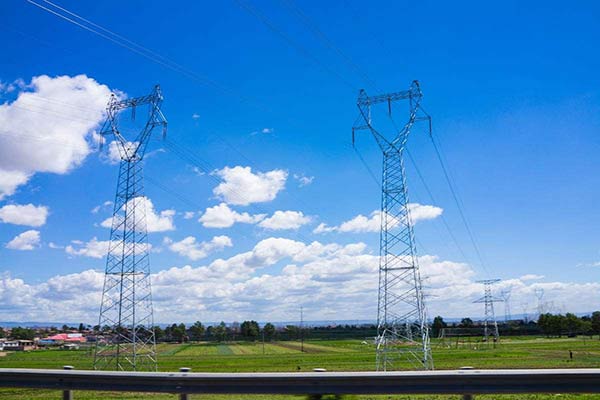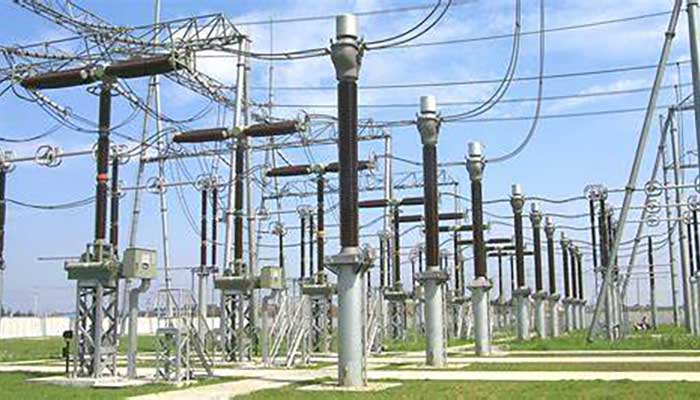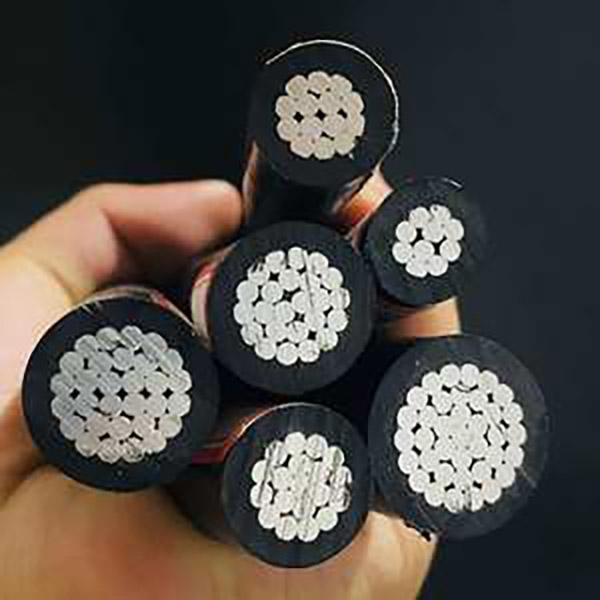No longer do we see a hodgepodge of cables everywhere in life. They have been cleverly placed in the air and called overhead cables. What is this all about? Today ZMS cable editor takes you to understand overhead cables.
Overhead Cable Definition
Overhead cable, full name overhead insulated cable.
It is equipped with insulation and a protective sheath of the overhead conductor, similar to the production process of cross-linked cable manufacturing a special cable. It is a new way of power transmission between overhead conductors and underground cables.
Overhead cables are single-core. Its structure can be divided into hard aluminum wire structure, hard drawn copper wire structure, aluminum alloy wire structure, steel core or aluminum alloy core support structure, and self-supporting three-core strip line structure.
The main structure of the whole overhead cable contains a cable line, overhead ground, tower, insulation, pulling wire, grounding device, etc.

Overhead Cable Structure
1. Conductor and Lightning Line
The conductor is used to conduct current, the transmission of electrical energy components.
Transmission lines are generally used overhead bare wire, one per phase, 220kV, and above lines due to the large transmission capacity.
At the same time to reduce corona loss and corona interference and the use of phase split wire, that is, each phase uses two and more wires.
The use of split conductors can transport larger power, and less power loss, with better vibration-proof performance.
1.1 Overhead Wire Arrangement
The arrangement of conductor in the tower has a single circuit line that can be used on the word, triangle, or horizontal arrangement.
There will also be on the double circuit line can be used umbrella, inverted umbrella, dry word, or hexagonal arrangement.
The conductor is often tested by various natural conditions in operation.
So it must have good electrical conductivity, high mechanical strength, light quality, low price, corrosion resistance, and other characteristics.
The role of the lightning line is to reduce the chance of lightning striking the wire, improve the level of lightning resistance, reduce the number of lightning trips, to ensure that the line is safe to send power.
1.2 Wire Ground Classification
Conductor ground can generally be classified according to the raw materials used or construction methods.
1.2.1 According to the classification of raw materials
Bare wire can generally be divided into copper wire, aluminum wire, steel-core aluminum wire, galvanized steel-stranded wire, etc.
Copper is a metal with good electrical conductivity and can resist corrosion.
But the specific gravity, high price, and mechanical strength can not meet the strength requirements of the large file distance.
Now the overhead transmission lines are generally not used.
Aluminum has a lower electrical conductivity than copper, lighter mass, and lower price.
Under the condition of the equal resistance value, the quality of the aluminum wire is only about half of the copper wire.
But the disadvantage is that the mechanical strength is low, after the formation of aluminum oxide film on the surface of the operation, the conductivity is reduced, and corrosion resistance is poor.
Therefore, high-voltage distribution lines are used more.
Transmission lines generally do not use aluminum-stranded wire. Although the mechanical strength of steel is high but has poor electrical conductivity, corrosion resistance is also poor and easy to rust.
Generally are only used as a ground or pulling wire, not as a wire.
High mechanical strength of steel, aluminum conductivity, the internal strands of the wire is a few steel wire to withstand the pull.
The exterior is a multi-stranded aluminum wire to conduct current.
Due to the skin effect of alternating current, the current passes mainly in the outer layer of the conductor.
This makes full use of the conductivity of aluminum and the mechanical strength of steel, complementing each other’s strengths and weaknesses.
The current overhead transmission line conductors almost all use steel-core aluminum wire.
As a good conductor ground and carrier channel with the ground line, also using steel-core aluminum wire.
1.2.2 According to the structure of the classification
According to the different ways of construction, a bare wire can be divided into a metal or two metal-stranded wires.
A metal multi-strand stranded wire has copper-stranded wire, aluminum-stranded wire, galvanized steel-stranded wire, etc.
As the transmission line uses less, here is not to introduce.
Two metals of multi-stranded stranded wire are mainly steel-core aluminum stranded wire, stranded wire has the advantage of easy bending.
Stranded wire of the adjacent two layers around the opposite direction, one is not easy to counter strength loose strands, and then the distance between each layer of wire is larger.
Increase the wire diameter, which is conducive to reducing corona loss.
Steel-core aluminum wire in addition to the normal type, there are two types of mitigation and strengthening types.
2. Overhead Cable Tower
The tower is the general name of the pole and tower.
The purpose of the tower is to support the wire and lightning line.
Make between the wire, wire and avoid wire and ground, and cross between the span of things to maintain a certain safety distance.
Tower classification
2.1 According to the Material Classification
Generally can be divided into cement poles and iron towers according to the raw materials.
2.1.1 Reinforced Concrete Pole
Abbreviated as cement poles.
The poles are composed of reinforced concrete pole sections with circular cross-sections, which are characterized by simple structure and easy processing.
The materials used, such as sand, stone, and cement, are easy to supply and cheap.
Concrete has a certain degree of corrosion resistance, so the pole has a long life and low maintenance.
2.1.2 Iron Tower
A tower is a three-dimensional truss assembled with steel and can be made into various heights and different forms of towers according to engineering needs.
There are steel pipe towers and steel section towers.
Tower mechanical strength, long service life, less maintenance work.
But the steel consumption is large and expensive.
In the substation in and out of the line and narrow channel 35 ~ 110kV can be used double circuit narrow base tower.
Compared with the tower, steel consumption is less, the line cost is low, but the weight is large, and transportation is more difficult.
There are two kinds of cement poles: non-prestressed reinforced concrete poles and prestressed reinforced concrete poles.
At present, the transmission lines use more non-prestressed poles.
2.2 Classification by Use
The pole tower can be divided into the following five categories according to its use.
2.2.1 Linear Pole
The straight-line pole is also called the middle pole.
It is distributed in the middle of the tension-resistant tower, the largest number, in flat areas, the number of the vast majority.
Under normal circumstances, the straight line pole only bears the vertical load and horizontal wind pressure.
Therefore, the linear pole is generally lighter and has lower mechanical strength.
2.2.2 Tensioning Rod
Tensioning rod is also called the load-bearing rod.
To prevent the line break when the entire line of straight line tower down the line direction.
Must be set up at both ends of the straight line section at a certain distance to withstand the line break along the line direction of the guide, the ground line pulls tower, and the line break impact is limited to a certain range.
The distance between the two tension-resistant towers is called the tension-resistant section.
2.2.3 Corner Pole
The line corner of the tower is called the corner pole.
Under normal circumstances, the corner pole in addition to the guide, ground line vertical load, and the direction of the inner corner parallelogram wind horizontal load, also bears the direction of the inner corner parallelogram guide, ground line all the combined force of tension.
2.2.4 Terminal Pole
The line terminal at the tower is called the terminal pole.
A terminal pole is installed in the power plant or substation line end of the tower.
Terminal pole in addition to bearing the guide, ground line vertical load, and horizontal wind.
Also bear the line side of the guide, ground line pulls, stability and mechanical strength should be relatively high.
2.2.5 Special Poles
Special poles are mainly transposition poles, spanning poles, and branch poles.
More than 10km of transmission lines to use the replacement pole for wire replacement. Crossing poles are located in navigable rivers, railroads, major highways, and wires on both sides to ensure that across the cross vertical distance.
3. Overhead Cable Insulators
The overhead power line insulator is a kind of insulation product.
Generally made of electrical ceramic, also called porcelain vases.
There are also glass insulators made of tempered glass and synthetic insulators made of silicone rubber.
The purpose of the insulator is to insulate between the wires and between the wires and the earth to ensure that the line has a reliable electrical insulation strength.
And used to fix the wire, bearing the vertical load and horizontal load of the wire.
In other words, the insulator should be able to meet the requirements of both electrical performance and mechanical strength
It has the main characteristics of high reliability of power supply, good safety of power supply, convenient erection and maintenance, and reasonable economy.
Its main technical parameters include weather resistance, insulation level, and internal and external semi-conductive shielding layer.

Overhead Cable Classification
Overhead cables are not ordinary oil paper insulated cables or cross-linked insulated cables directly hung on the overhead towers, but a special cable manufactured by a production process similar to that of cross-linked cables.
General overhead cables are single-core.
Its structure can be divided into hard aluminum wire structure, hard drawn copper wire structure, aluminum alloy wire structure, steel core or aluminum alloy core support structure, and self-supporting three-core grain structure.
The hard aluminum wire structure is light in weight, moderate in tension, easy to bend the cable, and easy to install.
And the project cost is low, can be conveniently installed in the existing tower, general transformation or new construction projects more use such.
Hard-drawn copper wire structure is heavier, but the tension is large, and the ability to resist the action of external forces is strong.
Even when the tower breaks the cable can continue to energize.
Aluminum alloy wire structure of lightweight, high tensile strength, mainly used in the span of 100m of the large span tower system.
Steel core or aluminum alloy core support structure is generally used for 35kV voltage system, span is also larger.
Square insulated parts are used to separate the bare wire and three insulated phase wires.
A support line can be used as a lightning line, its biggest advantage is the arc sag is small, and arc weight is only about 2.4% of the span.
A self-supporting three-core stranded structure is used in systems with medium spans.
The disadvantage of this cable is that the manufacturing length of the three-core cable is shorter than the single-core, with more joints.
And there is an outer semi-conductive shielding layer, at the end of the cable to be like ordinary cable device termination or stress cone structure.
The face of the world so many cables, in the selection of overhead cable how to choose it?
Here we will take the low-voltage overhead cable as an example.
1. Insulation Mechanical Properties
1.1 PVC is softer than PE and has high mechanical strength and good abrasion resistance. GB12527-90 standard, PVC tensile strength of 12.5MPa.
Polyvinyl chloride cable material tensile strength measured value reaches about 20 MPa.
The tensile strength of polyethylene is 10 MPa in the standard, which is lower than that of PVC, and the measured value is only about 14 MPa, which is much lower than the measured value of PVC.
1.2 When the cable is placed on the ground, PVC cable is not easy to be broken and hairy.
On the contrary, polyethylene is easy to be broken and hairy.
In the contact with the metal tool under pressure and the trunk and leaves contact friction, PVC is not easy to be crushed and wear out due to its high mechanical strength.
2. Atmospheric Aging Performance
The cross-linking process transforms the linear state of polyethylene molecules into a net-like structure by bridging them with cross-linking agents.
The molecular chains are tightly linked together at the top, bottom, and left side, which enhances the ability to resist external damage.
With the addition of light shielding agents and antioxidants, there is no need to worry about the ability of cross-linked polyethylene to resist atmospheric aging.
Summary of the selection of low-voltage overhead cables.
1. Low-voltage overhead PE insulated cables have excellent insulation performance though.
However, the mechanical properties are low, the flame retardant properties are poor, and the heat resistance is poor.
Especially in the resistance to environmental stress cracking also lacks a longer time overhead laying test and experience accumulation, it is recommended that long-term laying test research before considering the promotion of a large area.
2. Low-voltage overhead XLPE insulated cable has excellent insulation performance, mechanical performance, heat resistance, and non-deformation performance.
However, due to the high price, it is recommended that under the current economic conditions, it is more appropriate to use in special requirements.
3. Low-voltage overhead PVC insulated cables have the advantages of good atmospheric aging resistance, high mechanical strength, torsion resistance, wear resistance, and good flame resistance.
Insulation capacity and water resistance can meet the requirements of a low-voltage power grid.
Therefore, it should be the product of choice for low-voltage power grid transformation.
The above is a detailed introduction to the overhead cable.
France, Sweden, Finland, and other countries following its dense forest conditions, in the early 1960s, took the lead in the research and development of overhead cables.
Overhead cables have been widely used in Europe, the United States, Japan, and Southeast Asia. Including South Korea also began mass production of high-voltage overhead cable, using an overhead cable power supply.
ZMS cable company has always been concerned about the development of cable, always adheres to providing high-quality cable, good value for money, considerate service, the product after a strict manual qualification audit, trustworthy.
—ZMS Cable Group

